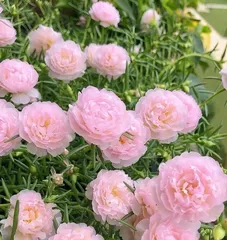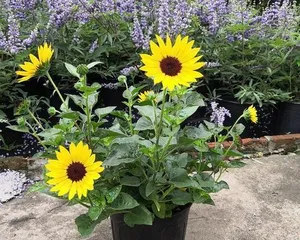Sunflowers are one of the most common sun-loving plants, and their beauty and growth process have attracted the attention of many people. However, in modern urban life, growing plants seems to have become a luxury, as many people do not have balconies or yards. Can sunflowers be grown indoors at home? This is a question that many people are concerned about. This article will introduce you to the characteristics and requirements of sunflowers in detail, tell you whether sunflowers are suitable for indoor growth, and how to care for them indoors.

Characteristics of Sunflowers
Sunflowers are a type of perennial herbaceous plant with a relatively fast growth rate, reaching over 1.5 meters in a good environment. Their flowers are yellow, with a black center in the flower disk, and are often called "sunflowers". Sunflower seeds are rich in nutrition, are high-protein, high-fat, and high-sugar foods, and oil can also be extracted from them. In addition, sunflowers are also ornamental plants, and their flowers and leaves are very beautiful.
Requirements for Sunflowers
Sunflowers are sun-loving plants and need at least 6 hours of direct sunlight per day to grow well. At the same time, sunflowers require loose, well-ventilated, and well-draining soil. The soil should not be too fertile, otherwise it will cause the sunflowers to grow too vigorously and bloom prematurely. Sunflowers also have certain requirements for temperature and humidity. In the early stages of growth, the ambient temperature should be kept around 20°C, and the humidity should be moderate, not too dry or too humid.

Advantages and Disadvantages of Growing Sunflowers Indoors
Advantages: Growing sunflowers indoors can effectively avoid the effects of the outdoor environment, such as wind, rain, and pests. At the same time, the indoor environment is relatively stable, which is beneficial for plant growth.
Disadvantages: The indoor environment is relatively lacking in sunlight, which is a great challenge for sunflower growth. In addition, the indoor air humidity is relatively low, and it is necessary to pay attention to regular watering and misting to maintain proper humidity.
Preparation for Growing Sunflowers Indoors
1. Purchase sunflower seeds: Buy healthy, pest-free sunflower seeds online or in physical stores.

2. Prepare a suitable container: Choose pots or planters with good ventilation and drainage. You can choose ceramic or terracotta pots.
3. Choose the right soil: Sunflowers have high requirements for soil, so you need to choose loose, well-draining nutrient soil.
4. Arrange the location: Choose a sunny, well-ventilated location for the sunflower, preferably next to a window or on a balcony.
Steps for Planting Sunflowers
1. Soak the seeds: Soak the sunflower seeds in warm water for 2-3 hours to facilitate germination.
2. Prepare the pot: Clean the pot and add an appropriate amount of nutrient soil.
3. Sow the seeds: Sprinkle the soaked sunflower seeds evenly on the surface of the nutrient soil, then gently pat them flat.
4. Cover the soil: Cover the seeds with an appropriate amount of nutrient soil.
5. Watering: Lightly spray the surface of the nutrient soil with a watering can to keep it moist.
6. Cultivation: Cultivate the sunflower in a suitable indoor temperature, while paying attention to providing sufficient sunlight and water.
Daily Care for Sunflowers
1. Watering: Keep the sunflower soil moist, but not too wet, otherwise it will cause root rot.
2. Mist the plant: In a dry indoor environment, you need to mist the plant regularly to increase air humidity.
3. Fertilizing: You can fertilize appropriately in the early stages of sunflower growth, but do not overdo it, as it may affect growth.
4. Pruning: Regularly prune the sunflower branches and leaves to keep them neat and beautiful.
5. Repotting: When the sunflower grows too fast or the pot soil is poor, it is necessary to replace the pot and nutrient soil in time.
Common Problems in Indoor Sunflower Care
1. Failure to bloom: This may be caused by insufficient sunlight or improper fertilization. It is necessary to increase sunlight and adjust the amount of fertilizer.
2. Wilting: This may be caused by overwatering or root rot. It is necessary to reduce watering and repot the plant.
3. Yellowing leaves: This may be caused by overly moist soil or lack of nutrients. It is necessary to adjust the amount of watering and fertilizing.
Precautions for Indoor Sunflower Care
1. Maintain ventilation: The indoor environment is relatively enclosed, so it is necessary to maintain proper ventilation, which is beneficial for plant growth.
2. Regular watering: Keep the sunflower soil moderately moist, but not too wet.
3. Moderate fertilizing: You can fertilize appropriately in the early stages of sunflower growth, but do not overdo it.
4. Avoid pests: The indoor environment is relatively dry, so it is necessary to prevent pests.
Suitability of Sunflowers for Indoor Growth
Overall, sunflowers are suitable for indoor growth, but it is important to ensure sufficient sunlight and well-draining soil.
Benefits of Growing Sunflowers Indoors
1. Beautify the indoor environment: Sunflowers are beautiful ornamental plants that can add a natural beauty to the indoor environment.
2. Purify the air: Sunflowers can absorb harmful gases in the air and purify the indoor air.
3. Increase the fun of life: The growth process of sunflowers is very interesting and can add fun and meaning to life.
Things to Note When Growing Sunflowers Indoors
1. Pay attention to keeping sufficient sunlight, otherwise it will affect the growth and flowering of sunflowers.
2. Pay attention to keeping the soil moderately moist, but not too wet.
3. Fertilize regularly, but do not overdo it, so as not to affect growth.
Conditions Required for Growing Sunflowers Indoors
1. Suitable location: Choose a sunny, well-ventilated location.
2. Suitable container: Choose pots or planters with good ventilation and drainage.
3. Suitable soil: Choose loose, well-draining nutrient soil.
4. Appropriate amount of sunlight and water: Ensure that the sunflower has sufficient sunlight and water.
Suitable People for Growing Sunflowers Indoors
1. People who like to grow plants.
2. People who do not have a balcony or yard but want to have some green plants.
3. People who have some control over sunlight and air humidity.
Taboos for Growing Sunflowers Indoors
1. Do not overwater to avoid root rot.
2. Do not over-fertilize to avoid affecting the growth of sunflowers.
3. Do not place it in a dark, humid place, as it will affect the growth of sunflowers.
In modern urban life, growing plants has become a fashionable and healthy lifestyle. As one of the most common sun-loving plants, the beauty and growth process of sunflowers have attracted the attention of many people. This article introduces the characteristics, requirements, advantages and disadvantages of indoor care, preparation, planting steps, daily care, precautions, benefits, and taboos of growing sunflowers in detail. I believe that through the introduction of this article, everyone has a deeper understanding of growing sunflowers indoors and can try to grow sunflowers at home to create a healthy and green life.